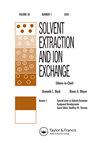Selective Extraction of Cu (II) Using Novel C=O–NOH-Contained Compound-Dodecyl Phenyl Ethyl Hydroxamic Acid and Its Extraction Mechanism
IF 2.1
4区 化学
Q3 CHEMISTRY, MULTIDISCIPLINARY
引用次数: 0
Abstract
ABSTRACT Herein, a novel C=O–NOH-contained compound was synthesized and used in the extraction and recovery of copper from sulfate solution. Dodecyl phenyl ethyl hydroxamic acid (DPEHA) exhibited high selectivity to Cu(II) over the competing ions, and the separation factors (β) obtained were β Cu/Zn = 227.370, β Cu/Co = 199.094, β Cu/Ni = 188.889, respectively. The separation effect was stronger than that of 2-hydroxy-5-nonyl acetophenone oxime. Meanwhile, extraction capacity of 0.10 g Cu(II) per gram DPEHA was reached, and the extracted Cu(II) can be stripped effectively. The investigation of extraction mechanism revealed that O atoms in C=O and O-H groups of DPEHA operate as active sites, which could powerfully chelate with Cu(II) by forming stable five-membered rings. The high copper extraction efficiency and selectivity associated with a simple synthesis of DPEHA make it to serve as the potential selective Cu(II) extractant, which also provide a novel insight for the research and development of economical Cu(II) extractants. Graphical Abstract新型含C= o - noh化合物-十二烷基苯基乙基羟肟酸选择性萃取铜(II)及其萃取机理
摘要本文合成了一种新型含C= o - noh化合物,并将其用于硫酸盐溶液中铜的提取和回收。十二烷基苯基乙基羟肟酸(DPEHA)对Cu(II)具有较高的选择性,得到的分离因子(β)分别为β Cu/Zn = 227.370, β Cu/Co = 199.094, β Cu/Ni = 188.889。分离效果优于2-羟基-5-壬基苯乙酮肟。同时,每g DPEHA萃取量为0.10 g Cu(II),萃取后的Cu(II)可以有效剥离。萃取机理研究表明,DPEHA的C=O和O- h基团中的O原子作为活性位点,能与Cu(II)形成稳定的五元环进行强螯合。DPEHA具有较高的铜萃取效率和选择性,且合成简单,可作为铜(II)的选择性萃取剂,这也为经济型铜(II)萃取剂的研究和开发提供了新的思路。图形抽象
本文章由计算机程序翻译,如有差异,请以英文原文为准。
求助全文
约1分钟内获得全文
求助全文
来源期刊
CiteScore
4.40
自引率
5.00%
发文量
15
审稿时长
8.4 months
期刊介绍:
Solvent Extraction and Ion Exchange is an international journal that publishes original research papers, reviews, and notes that address all aspects of solvent extraction, ion exchange, and closely related methods involving, for example, liquid membranes, extraction chromatography, supercritical fluids, ionic liquids, microfluidics, and adsorption. We welcome submissions that look at: The underlying principles in solvent extraction and ion exchange; Solvent extraction and ion exchange process development; New materials or reagents, their syntheses and properties; Computational methods of molecular design and simulation; Advances in equipment, fluid dynamics, and engineering; Interfacial phenomena, kinetics, and coalescence; Spectroscopic and diffraction analysis of structure and dynamics; Host-guest chemistry, ion receptors, and molecular recognition.

 求助内容:
求助内容: 应助结果提醒方式:
应助结果提醒方式:


